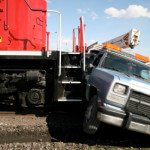 It may be hard to believe that there are still serious accidents between
cars and trains in an age where safety mechanisms, sensors, and mechanics
have come so far, but horrific collisions occur on an all too regular
basis. It is true that there has been a ninety-six percent (96%) decrease
in accidents involving trains and cars since 1985, there still is a collision
between a train and a car or person every two hours. The majority of these
accidents occur at railroad crossings and are attributable to malfunctioning
or nonexistent safety mechanisms.
It may be hard to believe that there are still serious accidents between
cars and trains in an age where safety mechanisms, sensors, and mechanics
have come so far, but horrific collisions occur on an all too regular
basis. It is true that there has been a ninety-six percent (96%) decrease
in accidents involving trains and cars since 1985, there still is a collision
between a train and a car or person every two hours. The majority of these
accidents occur at railroad crossings and are attributable to malfunctioning
or nonexistent safety mechanisms.
Between 2005 and 2010, there were almost 5,000 deaths, according to the United States Board of Transportation. In that same time period there were more than 30,000 train accidents, which include train derailments, train and pedestrian accidents, and train and car collisions. The causes of these accidents include driver error, where the car crossed the tracks into the path of an ongoing train. However, there also were many incidents involving dangerous train crossings, defective roadways or railroad tracks, and conductor error.
If you or a loved one has been involved in a collision between a car and a train, there are many considerations. It is important to have a thorough investigation into the accident site as there may be evidence of safety failures, including:
- Crossing gate malfunction - Crossing gates are the physical barrier between the tracks and vehicles waiting to cross. If they do not work properly, a vehicle is more likely to attempt to cross in front of a train.
- Property maintenance negligence - An area around the tracks that has not been cleared of shrubs, trees, debris, and man-made objects will block a driver's view down the tracks. Cars are less likely to try to beat a train if the driver has a clear view of the approach.
- Missed or delayed inspections - There are many dangers that could have been corrected if the track crossing was regularly inspected by whomever is responsible for the specific track and road intersection.
Once an accident has occurred, there are a number of steps to take as quickly as possible:
- Get medical care as soon as possible. Immediate attention is necessary even an injury is not apparent at the time of the accident. Soft tissue injuries often occur as a result of a collision between a train and a car because of the serious weight differential and the impact force.
- Have the accident scene investigated. A timely analysis of the accident site is critical as there can be significant modifications to the tracks, the roadway, the surrounding area, and the safety mechanisms through the impact of the elements and human intervention. It is important to document the scene and collect evidence as close to the time of the accident as possible.
- Reach out to the investigating officer. The law enforcement officer in charge will be responsible for diagramming the scene and reconstructing the accident, processing evidence, and collecting statements and information. The assistance of this individual is very important for a successful case.
Train and car collisions are unique because the train always has the right of way at a crossing and the burden is on the driver of a passenger vehicle must take affirmative measures to avoid putting the occupants of the car in harm's way. This does not mean that the train operator, owner, or the party responsible for crossing maintenance is never partially or completely responsible for an accident.
If you have been involved in an accident with a train, it is important to contact an experienced personal injury attorney to learn about your right to recovery. The skilled attorneys at Goeing Goeing and McQuinn PLLC are available to answer your questions. Please call us, or feel free to contact us through our website.
